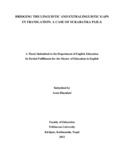Please use this identifier to cite or link to this item:
https://elibrary.tucl.edu.np/handle/123456789/303| Title: | Bridging the Linguistic and Extralinguistic Gapsin Translation: A Case of Sukaratka Paila |
| Authors: | Bhandari, Arun |
| Keywords: | Linguistic;Translation;Language;Master |
| Issue Date: | 2012 |
| Publisher: | Central Department of Education English |
| Abstract: | This thesis entitled,‘Bridging the Linguistic and Extralinguistic Gaps in Translation:A Case of Sukaratka Paila’, is an attempt ot find out the linguistic and extralinguisticgaps and explore the techniques used in bridging these gaps in the translated version ofthe novel ‘Sukaratka Paila’. The idea for the study was collected form both Nepaliversion of novel ‘Sukaratka Paila’ and English version ‘Sockrets’ Footsteps’. Thisresearch is mainly concerned with identification and categorization of the linguistic andextralinguistic gaps found in course of translation of novel. Both linguistic andextralinguistic gaps are studied together side by side. Iselected one hundred andfiftylinguistic gaps andtwenty sixother extralinguistic gaps available in the novel ‘SukaratkaPaila’.And they are grouped into two broad terms of the linguistic and extralinguisticfeatures. Linguistic category has further four and extralinguistic features have twocategories. In linguistic level lexical gap comprises lexical gaps in kinship terms,particles terms, reduplication, onomatopoeic etc. and structural gaps comprise gaps intense and aspect, articles, questioning, referential and non-referential it and there,negation and discourse marker, whereas extralinguistic gaps comprises culture based andsetting based extralinguistic gaps. The study consists of four chapters. Chapter one deals with the Introduction. It consists ofgeneral backgroundof the study, review of the related literature, objectiveandsignificance of the study. The second chapteris related to themethodology whichIapplied during my study. This chapter issub-grouped as the source of data, samplingprocedure, tools for datacollection, process of data collection and the limitation of thestudy. The third chapter includes analysis and interpretation of the data. Descriptiveapproach is used for the purpose. The fourth chapterdeals withfindings andrecommendations of the study |
| URI: | http://elibrary.tucl.edu.np:8080/jspui/handle/123456789/303 |
| Appears in Collections: | English Language Education |
Files in This Item:
| File | Description | Size | Format | |
|---|---|---|---|---|
| Cover.pdf | 33.58 kB | Adobe PDF |  View/Open | |
| Chapter.pdf | 476.21 kB | Adobe PDF |  View/Open |
Items in DSpace are protected by copyright, with all rights reserved, unless otherwise indicated.
